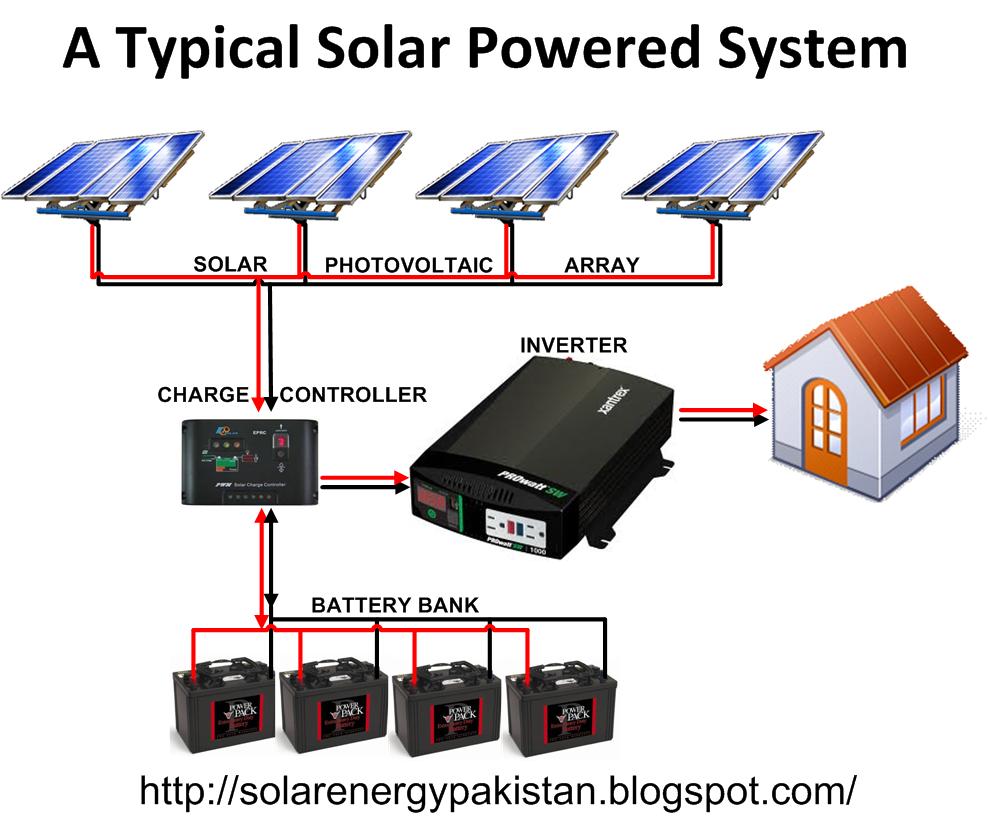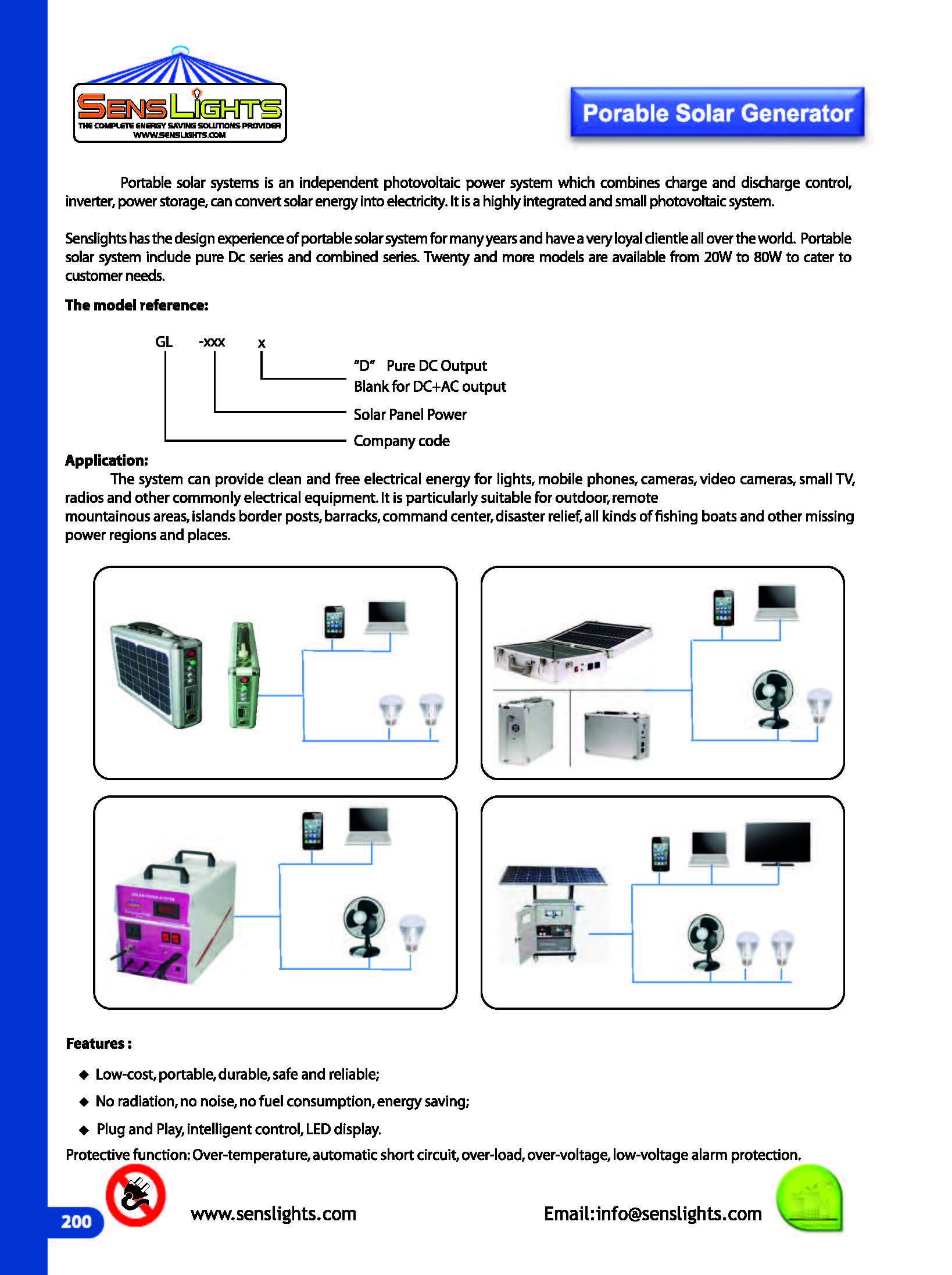Utility Free Power Station
1. Photovoltaic (“PV”) Panels Siemens Solar high-efficiency, single crystal silicon PV modules provide higher amp-hour per watt output than other technologies and include dual bypass diode protection. Modular PV panels permit expansion to accommodate increased loads.
2. Adjustable Array Structure PV array tilt is easily adjustable from 30-60 degrees to maximize solar energy. Further adjustment of 0-30 degrees possible with special positioning bars.
3. Control Center The control enclosure is a NEMA 4 powder coated steel box housing the power distribution components (DC Controller/distribution, Inverter and AC distribution), disconnects, system monitor and appropriate wire terminals. Enclosure is provided with rainproof vents and a ground fault protected electrical outlet. Optional remote monitoring equipment is available.
4. Inverter/Battery Charger Trace microprocessor-controlled high-efficiency, sine wave inverter with three stage temperature compensated battery charger. Peak conversion efficiency of 96%, protection circuitry, LCD display with user and setup menus.
5. DC Controller Solid state, low frequency, pulse-width modulated solar charge control with battery temperature compensation and automatic night time disconnect. Customer DC interface conforms to U.S. National Electric Code and provides easy access and flexibility for multiple DC load requirements.
6. AC Distribution Panel Customer AC breaker panel conforms to U.S. National Electric Code, provides surge protection and flexibility for multiple AC load requirements.
7. DC Combiner Box Provides PV circuit disconnects and lightning/surge protection for electronic equipment.
8. Ventilator Fan Designed for active ventilation of hybrid battery enclosure to prevent accumulation of hydrogen gas.
9. Batteries Available in three battery types: economy flooded lead acid, industrial flooded lead acid and sealed lead acid. Flooded lead acid battery comes with recombiner caps to minimize water loss. Sealed battery available for maintenance-free performance. The control system maintains the batteries between 20% and 100% state of charge.
10. Battery Enclosure Insulated, vented thermoplastic unit with lockable lid and drain plug. Designed to minimize battery temperature extremes, eliminate battery bank hot spots, prevent freezing and extend useful battery life. Industrial battery cells are secured within a grid and surrounded by a water jacket.
11. Generator (Hybrid only) Industrial air-cooled, propane generator results in reduced maintenance requirements. Includes battery, alternator, remote start/stop contacts, self-contained protection and automatic safety shutdowns. Package includes weatherproof housing, vibration isolators on steel skid, flexible couplings, and replaceable dry element air filter. Available in three sizes. Other fuel types available.
12. Structure Industrial grade, heavy-gauge steel coated with a durable polyurethane or optional galvanized finish. Available in four configurations: ground mount, road trailer, off-road trailer and breakdown kit.
Hybrid and Stand-Alone Configurations
Multitask Electronics™ Power Stations are available in two configurations: “hybrid” power stations that have a generator and “stand-alone” power stations, without a generator. The Multitask Electronics™ Hybrid Power Station uses a propane or diesel powered electric generator to supplement battery charging. The Multitask Electronics™ Stand-Alone Power Station is powered exclusively by the PV modules.
Several factors must be considered when choosing between a hybrid or stand-alone configuration. Hybrid stations are sized to provide 25-75 percent of the load requirements by the engine generator, resulting in a lower first-cost for a given load. Stand-alone PV systems are sized to provide 100 percent of the load during the worst case solar conditions, and offer very low operating and maintenance costs. While the hybrid units do require fuel supply and engine maintenance, engine run time and operating costs are greatly reduced relative to diesel engine installations. Refer to the chart below for more detailed comparative information.
|
|
PV Stand Alone
|
PV Hybrid w/Gen
|
Diesel
|
Utility Extension
|
|
Fuel Costs
|
None
|
Moderate
|
High
|
None
|
|
Reliability
|
Excellent
|
Depends on Maintenance
|
Depends on Maintenance
|
High
|
|
Relative Capital Costs
|
High
|
Moderate
|
Low
|
Depends on Distance
|
|
Relative Operating Costs
|
Low
|
Moderate
|
High
|
Low
|
|
Maintenance
|
Low
|
Moderate
|
High
|
Low
|
|
Fuel Dependence
|
None
|
Low
|
High
|
Moderate
|
|
Pollution
|
None
|
Low
|
High
|
Moderate
|



